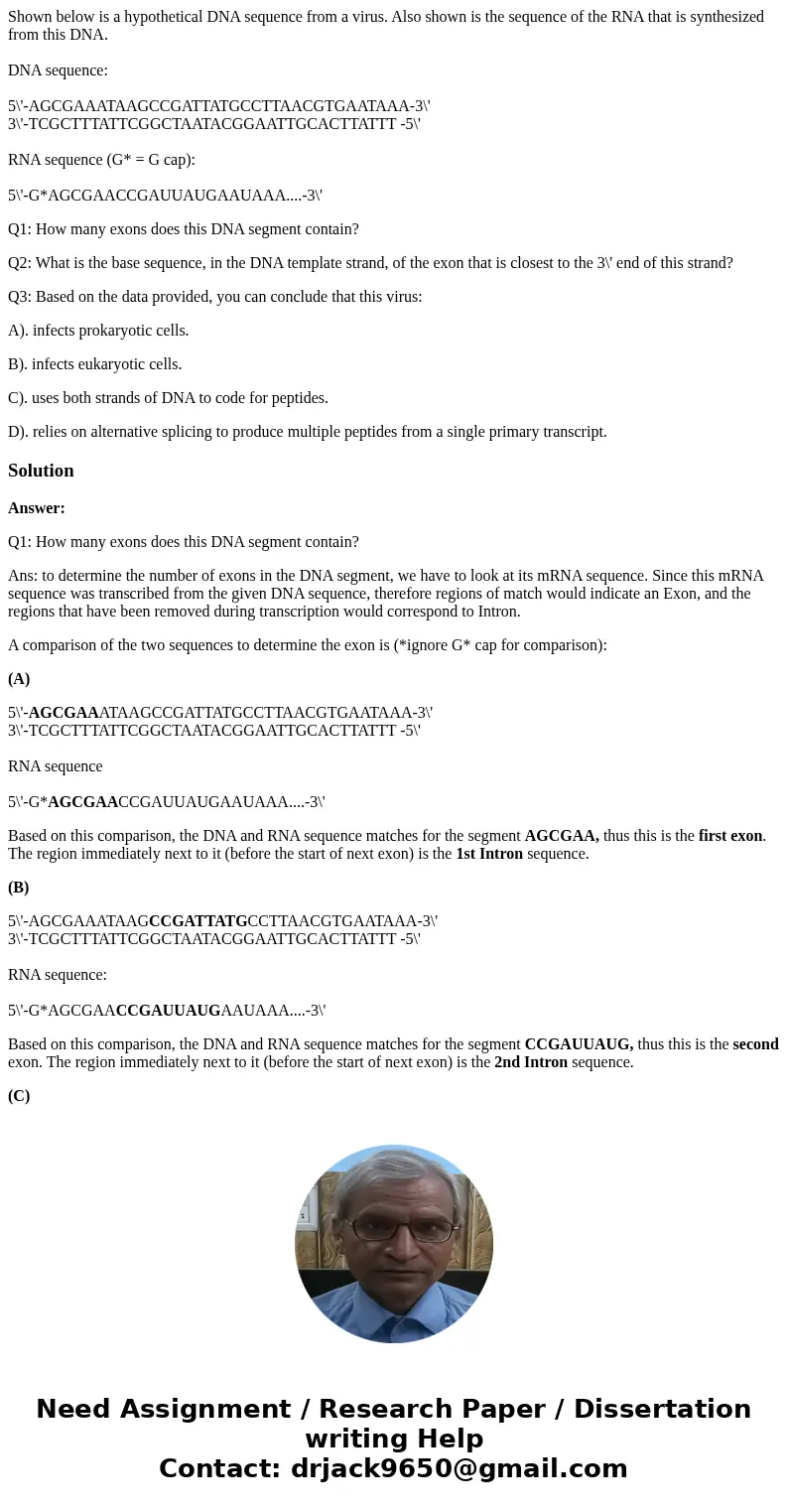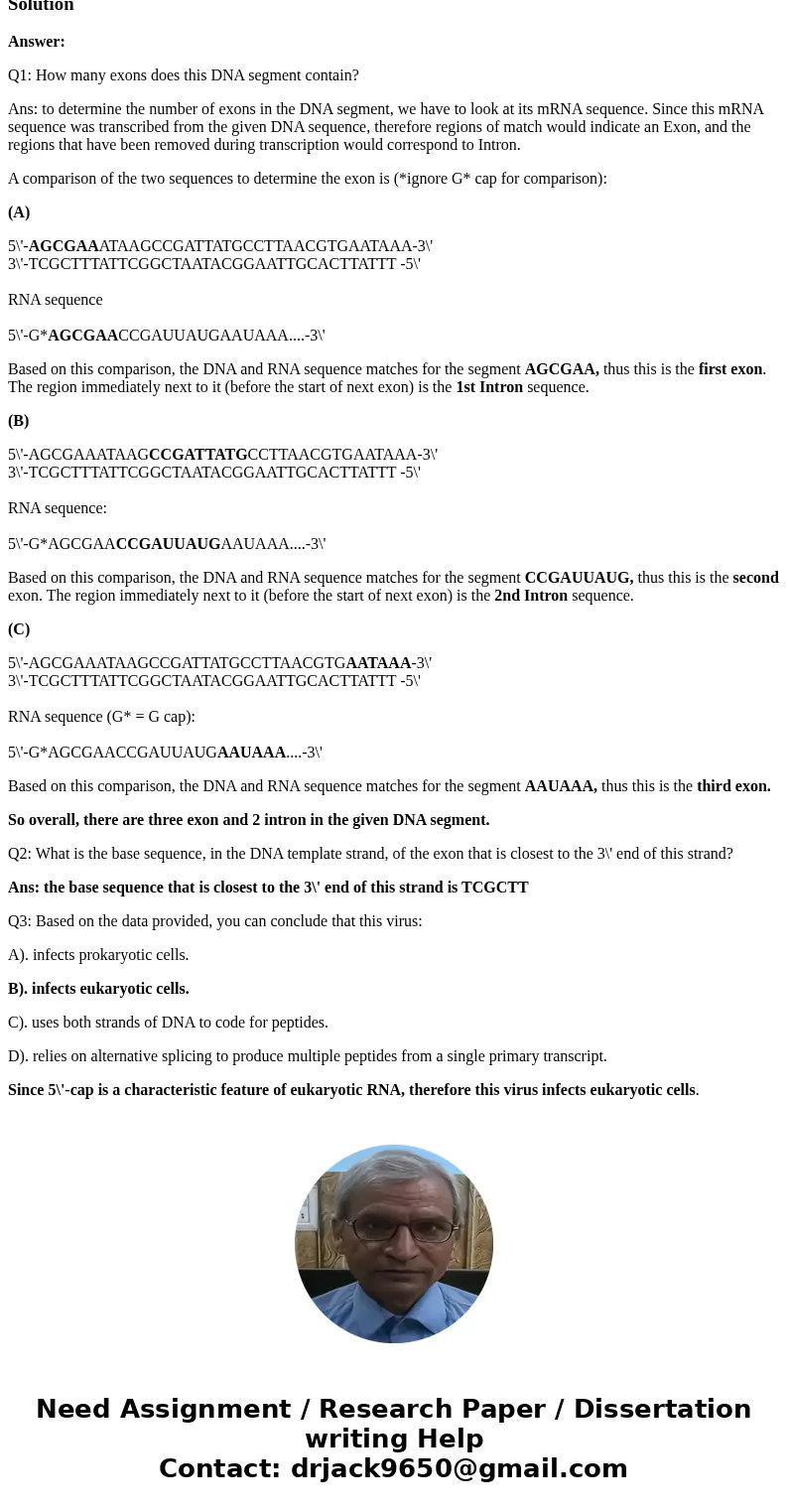Shown below is a hypothetical DNA sequence from a virus Also
Shown below is a hypothetical DNA sequence from a virus. Also shown is the sequence of the RNA that is synthesized from this DNA.
DNA sequence:
5\'-AGCGAAATAAGCCGATTATGCCTTAACGTGAATAAA-3\'
3\'-TCGCTTTATTCGGCTAATACGGAATTGCACTTATTT -5\'
RNA sequence (G* = G cap):
5\'-G*AGCGAACCGAUUAUGAAUAAA....-3\'
Q1: How many exons does this DNA segment contain?
Q2: What is the base sequence, in the DNA template strand, of the exon that is closest to the 3\' end of this strand?
Q3: Based on the data provided, you can conclude that this virus:
A). infects prokaryotic cells.
B). infects eukaryotic cells.
C). uses both strands of DNA to code for peptides.
D). relies on alternative splicing to produce multiple peptides from a single primary transcript.
Solution
Answer:
Q1: How many exons does this DNA segment contain?
Ans: to determine the number of exons in the DNA segment, we have to look at its mRNA sequence. Since this mRNA sequence was transcribed from the given DNA sequence, therefore regions of match would indicate an Exon, and the regions that have been removed during transcription would correspond to Intron.
A comparison of the two sequences to determine the exon is (*ignore G* cap for comparison):
(A)
5\'-AGCGAAATAAGCCGATTATGCCTTAACGTGAATAAA-3\'
3\'-TCGCTTTATTCGGCTAATACGGAATTGCACTTATTT -5\'
RNA sequence
5\'-G*AGCGAACCGAUUAUGAAUAAA....-3\'
Based on this comparison, the DNA and RNA sequence matches for the segment AGCGAA, thus this is the first exon. The region immediately next to it (before the start of next exon) is the 1st Intron sequence.
(B)
5\'-AGCGAAATAAGCCGATTATGCCTTAACGTGAATAAA-3\'
3\'-TCGCTTTATTCGGCTAATACGGAATTGCACTTATTT -5\'
RNA sequence:
5\'-G*AGCGAACCGAUUAUGAAUAAA....-3\'
Based on this comparison, the DNA and RNA sequence matches for the segment CCGAUUAUG, thus this is the second exon. The region immediately next to it (before the start of next exon) is the 2nd Intron sequence.
(C)
5\'-AGCGAAATAAGCCGATTATGCCTTAACGTGAATAAA-3\'
3\'-TCGCTTTATTCGGCTAATACGGAATTGCACTTATTT -5\'
RNA sequence (G* = G cap):
5\'-G*AGCGAACCGAUUAUGAAUAAA....-3\'
Based on this comparison, the DNA and RNA sequence matches for the segment AAUAAA, thus this is the third exon.
So overall, there are three exon and 2 intron in the given DNA segment.
Q2: What is the base sequence, in the DNA template strand, of the exon that is closest to the 3\' end of this strand?
Ans: the base sequence that is closest to the 3\' end of this strand is TCGCTT
Q3: Based on the data provided, you can conclude that this virus:
A). infects prokaryotic cells.
B). infects eukaryotic cells.
C). uses both strands of DNA to code for peptides.
D). relies on alternative splicing to produce multiple peptides from a single primary transcript.
Since 5\'-cap is a characteristic feature of eukaryotic RNA, therefore this virus infects eukaryotic cells.


 Homework Sourse
Homework Sourse